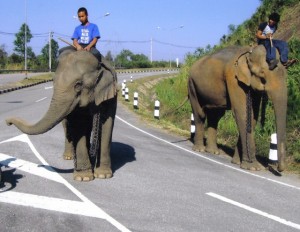Thailand Driving Advice and Car Hire Info
Driving in Thailand
Thailand drives on the left and you require an international driving permit and your own licence to rent a car. Roads are generally in good condition compared to neighbouring countries. A system of multi lane expressways and motorways, some of which are toll roads, connect Thailand’s major urban areas..A downside of the well maintained roads is that drivers can go faster, and this is reflected in Thailand’s high road death rate.In 2016, 32.7 out of every 100,000 Thais died on the country’s roads, according to the most recent WHO estimates. By comparison, the road fatality rate in the United States was 12.4 that year. Smaller rural roads are less likely to be well maintained and some will be in poor condition, particularly after heavy rain.
Large towns and Bangkok in particular have very heavy traffic composed of motorcycles, cars, trucks, buses, and tuk-tuks. Motorbikes and tuk tuks are likely to drive in an erratic manner – weaving between lanes and overtake on both sides of slower moving traffic. Traffic accidents are common in Thailand, and often involve 2 and 3 wheel vehicles.
The accident rate in Thailand increases during holidays, when alcohol use and traffic are both heavier than normal. During the Songkran (Thai New Year) holiday in April, the problem is worsened by people throwing water at passing vehicles as part of the traditional celebration. On main roads between towns speeding, reckless overtaking and flouting of traffic laws is common in all regions of Thailand. Bus and lorry drivers often use amphetamines to stay awake and serious bus crashes occur frequently, especially on overnight trips. You should exercise caution around buses and lorries.
On some of the Thai Islands roads are mostly gravel and can be in poor condition. You should check with the rental company if you intend to take a hire car to an Island as additional insurance may be needed.The same applies to some National Parks where you may need a 4X4 or a vehicle with high clearance. This is the case in Kaeng Krachan National Park. Advice from DriverAbroad.com user Annabel Young- If you drive into the park you do need a vehicle with high clearance or 4X4, as the main road is a steep, rutted track at times and there are some steep drops in and out of the streams north of the first campsite. Also one of the routes from Hua Hin to Kaeng Krachen involves a very steep sandy bit of ‘road’. The road north of Hua Hin to the park is in better condition though.
Although I try and keep the information in the site updated as much as possible, in a rapidly moving world, situations can change daily. Therefore please use the site as an approximate guide, and in conjunction with other resources in order to form your view on driving conditions, roads, safety etc.

Thailand Car Rental –
Sixt, Hertz, Europcar, National, Budget,Avis, have branches here.Also usually features on Car rental broker sites and Web discount sites such as LastMinute.com
We currently have no local car rental partners in Thailand. If you are a local car rental company who would like to feature on DriverAbroad.com please check details on our Partnering page or contact us on ADriverAbroad@Outlook.com.
Thailand Self Drive Rules
None of the big companies allow cars to be taken out of Thailand. There are also restrictions on taking cars on ferries- you should check out terms with the company at the time of reservation.
For ex-pat drivers who purchase their own vehicle in Thailand, some information on insurance is provided by https://www.easycompare.co.th/-
Thailand Car Insurance
To drive a vehicle in Thailand without insurance cover is like betting with destiny. This is most likely why it is an obligation for vehicles to have the Compulsory Motor Insurance (CMI), or also locally called the “Por Ror Bor”. It is the most basic prerequisite you require in Thailand. It gives limited cover for clinical costs and death covers following an accident. Notwithstandingly, it doesn’t pay for vehicle damages. Subsequently, voluntary motor insurance for your own peace of mind and indemnity is encouraged. In Thailand, the additional covers are referred to as Class 1, Class 2+, 3+ or Class 3. The differences between them can be overwhelming for foreigners looking at migrating and retiring in Thailand. By measure of sound practice, in the unfortunate occurrence of an accident with personal injury, you may call 1554 for ambulance or 191 for police assistance. As is the international norm, the exchange of Vehicle Registration Number, Name, Address, ID, and Contact Number of Insurer and witnesses is expected.



